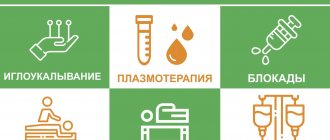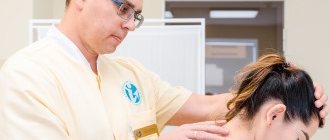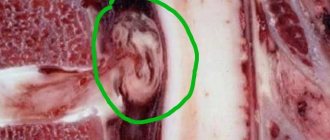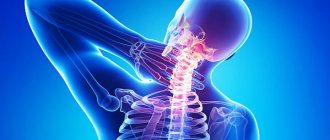Spondyloarthrosis of the thoracic spine is called dorsarthrosis. This pathology is one of the forms of osteoarthritis, which is characterized by degenerative-dystrophic changes in the structures of the facet joint, namely:
- ligaments;
- cartilage;
- periarticular muscles;
- capsules;
- bones.
Spondyloarthrosis of the thoracic region is a less common pathology affecting the facet joints. Diagnosis of the disease is difficult due to the fact that access to them is blocked by the ribs. There is an opinion that there are many more patients suffering from this disease, but the disease itself develops too slowly to manifest itself fully.
What it is
Thoracic spondylosis is a degenerative pathology of the spinal column , which occurs in a chronic form and is characterized by the presence of bone growths in the vertebrae, ossification of ligaments in the thoracic spine. This condition leads to limited mobility of the vertebrae.
Clinical picture
The growths on the vertebrae are shaped like spines . They are the body’s response to degenerative processes occurring in the tissues of the intervertebral discs. This is how the shock-absorbing properties of the disc are compensated.
Osteophytes support the vertebrae for some time when the functions of the intervertebral discs decrease. Then they grow, significantly increase in size, narrowing the spinal canal, the cartilage tissue of the discs is injured, the nerve endings can be compressed, which causes pain in the thoracic region.
Spondylosis occurs due to degenerative changes in the vertebrae
At an advanced stage of the disease, osteophytes grow, new ones appear, the vertebrae fuse, which leads to immobility of the thoracic region and deformation of the spine.
Classification
Depending on the severity of the disease, thoracic spondylosis has varying degrees of progression.:
- first degree There is a slight change in the curvature of the spine, sometimes leading to limited movement;
- second degree . Limited mobility of the spinal column occurs, which is assigned to a third group disability;
- third degree . Fusion of the vertebrae occurs, leading to complete immobility of the thoracic spine.
In addition, depending on the course of the disease, thoracic spondylosis can be:
- slowly flowing;
- moderate current;
- rapidly progressing;
- fulminant.
Important! Most often, with a rapid or lightning-fast course, the disease is a consequence of other diseases of the spine, in which thoracic spondylosis is a complication.
Prevalence and significance
Since the thoracic region is inactive due to the rigid rib frame, thoracic spondylosis is a rare disease . Most often found in people whose work is sedentary.
Thoracic spondylosis should be treated as soon as signs of the disease are detected. Deforming processes progress and lead to immobility of the thoracic region; with severe pinching of nerve fibers, paralysis is possible.
How are disability groups assigned?
Disability can only be obtained when the disease reaches a certain stage. In the absence of proper treatment, progression of spondylosis is inevitable.
- At the first stage, the patient cannot receive a disability group. Despite the fact that osteophytes are already beginning to form on the vertebrae, they do not interfere too much with a person’s life. The mobility of the spine is limited, but not completely. In the photographs you can see that the growths have not yet left the perimeter of the vertebrae.
- Due to impaired mobility of the spine at the second stage, the patient has the right to qualify for the third disability group. To do this, he will need to pass a commission. She will give a conclusion on the assignment of disability if, on x-rays, the growths have left the vertebrae.
- The third stage is the most severe; a second or first disability group may be assigned to it. The choice of group depends on the degree of vertebral fusion and the location of the disease. In photographs, osteophytes resemble staples. There is also a narrowing of the intervertebral canals. Vertebrae may be shortened.
Staples on the spine can form in different parts. In some cases, the fusion is so strong that a person cannot independently perform basic movements, then the first disability group is assigned. Otherwise, at the first stage, it’s time to apply for the second group. Disability is assigned by decision of a medical council.
Risk factors, causes
The following factors can lead to the development of thoracic spondylosis::
- spinal injuries;
- uneven loads on the spine, carrying heavy objects with a load on one side;
- staying in one position for a long time without breaks for rest or warm-up (especially sedentary work);
- hereditary predisposition to structural changes in the spine;
- old age, when the muscular frame of the spine is weakened;
- lack of microelements in the body that contribute to the normal development of bone tissue (calcium deficiency);
- poor circulation in the thoracic spine;
- overweight, obesity;
- prolonged and systematic exposure to drafts.
In addition, thoracic spondylosis can be a side symptom of the development of scoliosis or spinal kyphosis.
Video: “Causes of pain in the spine”
Consequences
Complications and consequences of thoracic spondylosis of the spine may include the following rather serious health indicators::
- spinal canal stenosis;
- complete paralysis;
- intervertebral hernia;
- disruption of internal organs.
Among the consequences of the proliferation of osteophytes are spinal canal stenosis and hernia
In the absence of timely treatment, spondylosis in the thoracic region can spread to the lumbar and cervical regions.
Symptoms and diagnostic methods
The main symptom of spondylosis is limited movement of the pathologically developing part of the spine, back pain, which can be chronic or appear systematically.
As a rule, a visit to a doctor occurs already in moments of acute pain symptoms, as well as when it is impossible to fully turn, bend and perform any movements without pain. At this stage, the disease is already in a rather severe stage.
In addition, thoracic spondylosis may be accompanied by other symptoms.:
- chest pain, which is often confused with angina pectoris;
- muscle spasms in the sternum area;
- inability to breathe fully;
- the inability to stay in one position for some time; you always want to take a more comfortable position;
- insomnia due to sudden pain when turning;
- numbness of the limbs.
Important! If you experience any symptoms of spondylosis, you should immediately visit a doctor. Based on the examination, the doctor can make a diagnosis and determine the nature of treatment. Based on the patient’s complaints, the specialist studies the specifics of pain syndromes, conducts a fiscal examination, and then prescribes a hardware examination of the spinal column.
The diagnosis of spondylosis of the thoracic spine can be determined based on studies:
- radiography . A direct and lateral examination is carried out, in which the presence of bone growths is determined;
- computed tomography . The condition of the spinal canal is determined;
- MRI . The condition of the discs and the presence of degenerative processes occurring in the vertebrae are considered;
- electroneuromyelography , which allows you to determine the condition of nerve fibers and the degree of their damage;
- ultrasound examination . The condition of the blood vessels along the spine is examined;
- radioisotope scanning . Helps identify possible inflammatory processes or other formations.
Based on the results of the study, the doctor determines the degree of neglect of the disease and prescribes the appropriate stages of treatment.
Laser therapy for spondylosis deformans
With the help of laser therapy, microcirculation improves, tension in the spinal muscles decreases, pain syndrome and dependence on medications decrease. Laser therapy gives a good effect in combination with methods of cleansing the body and taking vitamins A, C and E. Manual therapy helps if there are no traumatic injuries to the spine.
The prescription of a course of laser therapy is preceded by examination using MRI, computed tomography and radiography of the spine, which helps to establish an accurate diagnosis that excludes the influence of other diseases.
A course of laser therapy lasts from 10 to 15 sessions, which are carried out daily or every other day. If necessary, the course is repeated no earlier than 1 month after the end of the previous one.
Additional materials:
- Laser therapy for osteochondrosis
- Laser therapy for arthrosis (quantum photophoresis)
- Laser therapy for osteoarthritis
- Laser therapy for diseases of the joints and spine
- Laser medicine in elite sports
Treatment
Did you know that...
Next fact
Treatment of spondylosis of the thoracic spine is complex. It is almost impossible to cure thoracic spondylosis, however, alleviating the condition, improving metabolic processes in cartilage tissues, relieving pain, strengthening muscles, and also preventing further growth of osteophytes is a feasible task with a long recovery process. To do this, several methods are used in parallel.
Drugs
Pay attention to the list of drugs that are used for spondylosis. To relieve pain syndromes and relieve inflammatory processes in spondylosis, the following groups of drugs are prescribed:
- non-steroidal anti-inflammatory drugs;
- glucocorticosteroids that can relieve severe pain;
- chondroprotectors. Promote the restoration of cartilage tissue;
- antidepressants. Provide a decrease in the pain threshold, stabilization of the nervous system;
- muscle relaxants. Relieves muscle spasms that occur with spondylosis.
To relieve pain in the thoracic region, novocaine blockade or injections of anti-inflammatory painkillers can be used.
Exercises, exercise therapy, massage
In parallel with taking medications, the doctor prescribes additional treatment: gymnastics, massage.
Important! If there is an inflammatory process in spondylosis, you should first remove the inflammation, and then proceed to additional treatment methods. If there is inflammation, you should not do massage, and in some cases, exercise even with a slight load.
Therapeutic gymnastics is aimed at strengthening the muscles along the spine and back , relieving the tone of muscle fibers in the pathological region. Exercises can be carried out not only at home: some elements of gymnastics and relaxation can be performed right at the workplace.
For example, in a sitting position, lower your arms, relax them and smoothly raise and lower your shoulder joints. You can also hold the stupa seat with your back straight and lift your legs.
Exercises, their regimen and intensity of implementation should be prescribed by a specialist depending on the patient’s physical ability to perform them, as well as depending on the severity of spondylosis.
Massage has a positive effect on muscle tissue, relaxes and improves blood circulation, especially in the area that requires treatment. You can use additional massage methods using cupping, as well as apply treatment methods with medicinal leeches, acupuncture, and laser therapy.
- exposure to current with the introduction of additional medications - has a positive effect on the restoration of nervous tissue and improvement of blood circulation
Video: “Exercises for pain in the thoracic region”
Surgery
The method of surgical intervention is a last resort treatment when other methods have not brought a positive result. The operation is prescribed when it is necessary to eliminate the fusion of the vertebrae and release the nerve fibers when they are compressed. After removing the growths, special fixing elements are installed to strengthen the spinal column.
Treatment at home
At home, you can treat spondylosis with rubbing. Home treatment methods are aimed at reducing pain and inflammation, however, they are not able to prevent the development of the disease.
It is advisable to use folk recipes as maintenance therapy in addition to the main treatment prescribed by a doctor.
It is useful to rub your back in the thoracic region with fir oil at home.
Tea made from sunflower root can reduce the amount of salt deposits.
Pepper tincture as a rubbing agent increases blood circulation and helps improve metabolic processes in the tissues of the spine.
These and other home treatments must be agreed with your doctor so that self-medication does not turn out to be disastrous.
Prevention
Since, due to changes in the lifestyle of the population in favor of working at the computer, spinal diseases are becoming a fairly young pathology, you should take care of the posture and health of the spine from an early age.
The main recommendations for keeping your back healthy are::
- get used to foods containing little salt;
- balance physical activity with your abilities, do not overload your spine with a heavy burden;
- If you have a sedentary lifestyle, try to warm up as often as possible;
- Daily exercise will improve your posture and keep your spine healthy.
You should eliminate bad habits and eat less fatty foods. Swimming in the pool is useful for strengthening the back muscles, and also promotes relaxation and improves general condition.
Depending on the stage of the disease, we choose one or more treatment methods in Odintsovo:
Therapeutic massage, osteopathy, manual therapy in Odintsovo
Helps bones and joints take the correct physiological position, relieves pain and spasms, relaxes muscles.
Acupuncture in Odintsovo
Work on biologically active points. It affects the affected area and the body as a whole. Eliminates the cause of the disease and removes the symptoms.
In addition, according to indications, the following are used: taping, pharmacopuncture, FormTotix insoles, exercise therapy with an instructor and other methods. The choice of procedures depends on the current condition; taken together, they act faster and give a more lasting result.
doctor chiropractor









